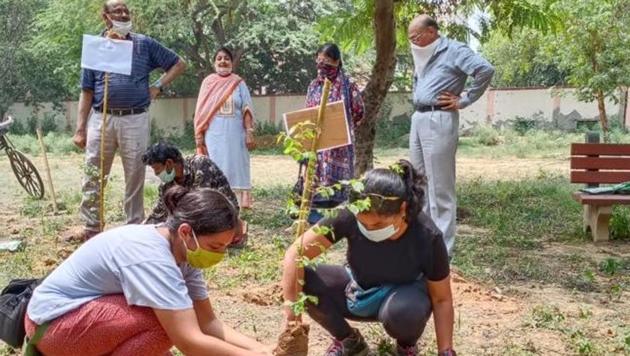Residents of two south Delhi localities on a mission to bring back native trees to parks
Monsoon is the season for plantation when millions of saplings are planted across the city by various agencies. The Delhi government targets the plantation of 31 lakh saplings this year.
Native trees may soon populate the avenues and parks of the national capital with more and more people taking up the planting of indigenous plant species, the latest being the efforts of residents from the south Delhi neighbourhoods of Sarvodaya Enclave and Vasant Vihar, who are planting these saplings in public parks with the help from civic bodies.

Monsoon is the season for plantation when millions of saplings are planted across the city by various agencies. The Delhi government targets the plantation of 31 lakh saplings this year. It has been encouraging citizens to plant more trees through free distribution of saplings to increase the overall green cover of the city.
The residents, along with environmentalists, have taken it upon themselves to enrich the biodiversity of Delhi-NCR and have tied up with the South Delhi Municipal Corporation (SDMC). The civic body, which is the custodian of parks, will help with the watering of all saplings while residents will engage their own labour and resources for the plantation drive.
The saplings are being sourced from different organisations, including the Aravalli Biodiversity Park, Gurugram, and various NGOs, said Padmavati Dwivedi, a resident of Sarvodaya Enclave, who is leading the initiative.
The residents in Vasant Vihar have planted nearly 100 native trees, such as such as bel, arjun, dhak, doodhi, khejri, and bargad, among others, in a 1.8 acre park along the Munirka Marg last week.
“We took permission from the civic body and they were happy to help us. We have planted around 100 native saplings at the Murika Marg park. The park mostly has kikar (an invasive species), which we are trying to replace with native varieties. Also, we have roped in an agency to help set up a mini forest inside the park. We also plan to have a herbal and native plants nursery, a bamboo grove and a butterfly garden,” said Keshav Garg, president, Vasant Vihar, Block D RWA.
A chartered accountant by profession, Garg is a nature enthusiast and has been working on this project for almost a year. “We have been making manure using kitchen waste from 200 households at one of the parks here. The manure is used in the plantation. Also, I have taken permission from the Delhi Jal Board and have installed a sewage treatment plant for the park. We are yet to get approval from the SDMC to operate the STP, “ Garg said.
A senior SDMC official, who did not wish to be named, said, “We had received a request from residents for the plantation drive. The horticulture department decides where the pits will be dug for plantation while residents will carry out the plantation.”
Sohail Madan, an ecologist and centre manager of the Conservation Education Centre at Asola Bhati sanctuary, who is helping residents with the butterfly garden said it is crucial for public parks to have a rich biodiversity to support local organisms.
“I will hold a webinar to educate residents on the basics of how to make a habitat for butterflies and what plants are required. I will also assist them with the plantation. Wild and native varieties such as peela vajradanti, citrus plants and patharchatta, among others, are required for butterflies to lay eggs on. The life cycle of a butterfly will go on, which will attract other predators such as lizards, spiders and bees, adding to the biodiversity of the area. Mostly, public parks only have trees that do not have any biodiversity value, which is why this initiative is so heartening,” Madan said.
Mona Jugran, a resident of Sarvodaya Enclave, has helped plant around 30 native shrubs in two corporation parks in her neighbourhood. “I have my own kitchen garden and have been participating in tree walks. I hope that the plants grow well,” she said.
The native varieties being grown by residents include dhau, goya khair, goondi, bistendu, gangeti, jhinjeri, khejri, dhak, doodhi, kaim, Harbor, peela vajradanti,chamrod, papdi and vallaris, among others.
“The interest is catching on. Residents from neighbourhoods such as Gulmohar Park have asked me for native plants to grow in pots. We hope that this trend becomes a full-fledged movement to support the city’s green cover,” Dwivedi said.
She added that native plants are best for biodiversity and require less maintenance, making them a perfect choice for a dry and hot capital.
A senior forest department official said every year, they keep saplings for free distribution, all of which are of native varieties. “This year, we have kept around five lakh saplings for free distribution, and 99% of them are natives. Besides, in view of the Covid-19 pandemic, we have also got medicinal plants such as giloy, tulsi and amla, among others.”
Vijay Dhasmana, curator, Aravalli Biodiversity Park in Gurugram, said they have a huge citizen volunteering programme and they distribute plants for such community initiatives(as otherwise they do take monetary contributions) free of cost. “Mostly public parks have exotic or ornamental trees, which doesn’t support the biodiversity. Through such initiatives, people become aware of native plants and what is important for a natural habitat.”
Stay updated with all top Cities including, Bengaluru, Delhi, Mumbai and more across India. Stay informed on the latest happenings in World News along with Delhi Election 2025 and Delhi Election Result 2025 Live, New Delhi Election Result Live, Kalkaji Election Result Live at Hindustan Times.
Stay updated with all top Cities including, Bengaluru, Delhi, Mumbai and more across India. Stay informed on the latest happenings in World News along with Delhi Election 2025 and Delhi Election Result 2025 Live, New Delhi Election Result Live, Kalkaji Election Result Live at Hindustan Times.






